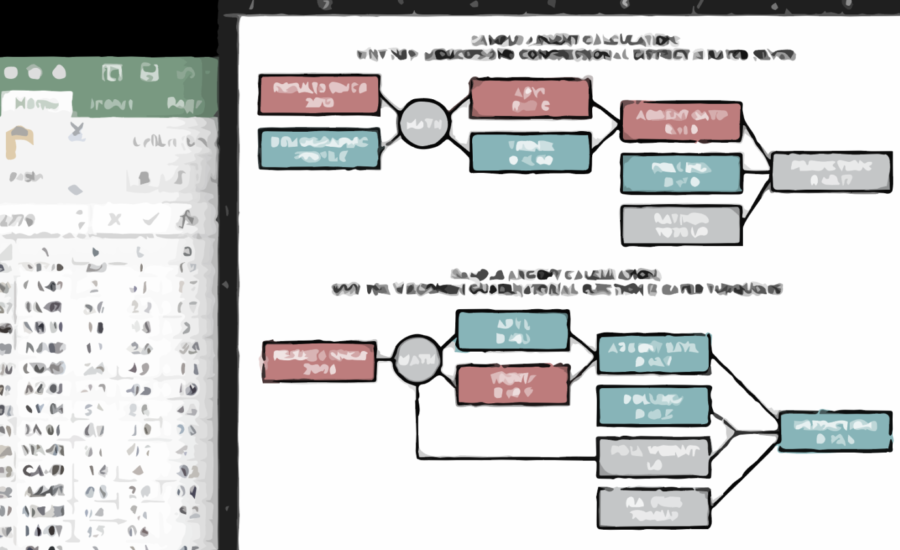Midterm Madness Part IV: What Happened
Democrats took the House and Republicans held the Senate, but so much more happened on Nov. 6. When the blue wave crashed down, the fundamental balance of power in dozens of states was shifted in ways that will affect us for years to come. But first things first: what exactly happened?
Democrats took the House
*At the time of this writing, North Carolina’s 9th congressional district is under contention due to accusations of election fraud by the GOP. For the purposes of this article, I consider it a Republican hold even though a new election in 2019 is likely.
Democrats won the national popular vote by 8 percent and made a net gain of 40 seats in the House for a breakdown of 235 Democrats to 200 Republicans. Democrats gained 22 seats that voted for Hillary Clinton and 21 seats that voted for Trump. Republicans also took three open-seats formerly held by Democrats.
My model for forecasting the 2018 election, ARGENT, assigned every single race a rating based on a color. Cobalt meant that the race was safe for Democrats. Turquoise meant that it was competitive, but Democrats had a sizable advantage. Silver meant that it was too close for ARGENT to make a certain prediction. Copper meant that it was competitive, but Republicans had a sizable advantage. Ruby meant that a race was safe for Republicans.
Democrats won 187 out of 187 cobalt seats, 25 out of 26 turquoise seats and 18 out of 34 silver seats. Republicans won 41 out of 45 copper seats and 141 out of 142 ruby seats. This means that ARGENT called 98.6 percent of non-silver House races correctly.
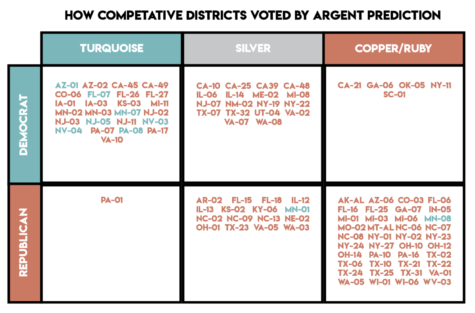
How each competitive house seat voted in 2018 versus how it should have voted according to the model ARGENT. The color of each congressional district indicates who controlled it before 2018.
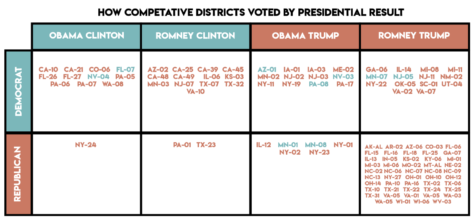
How each competitive house seat voted in 2018 versus how it voted for president in 2012 and 2016. The color of each congressional district indicates who controlled it before 2018.
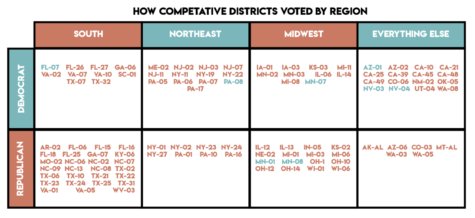
How each competitive house seat voted in 2018 by region. The color of each congressional district indicates who controlled it before 2018.
Gerrymandering played a role in the number of seats Democrats won. Although it can be said that Democrats beat the gerrymanders in Michigan, Virginia, South Carolina, Utah and Oklahoma, the same is not true for other states.
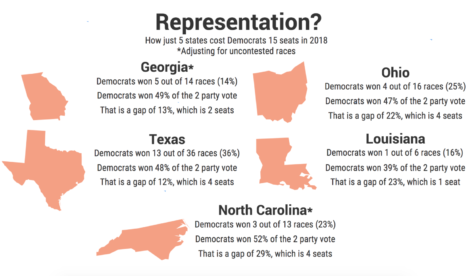
Infographic displaying the discrepancy between popular vote and seat distribution in 5 states with egregious GOP gerrymandering.
Republicans expanded their Senate majority.
Republicans gained four Senate seats from Democrats while Democrats gained two Senate seats from Republicans, for a breakdown of 53 Republicans to 47 Democrats, plus two independents who caucus with the Democrats. Republicans gained four of the 10 Democrat-held Senate seats in states that Trump won in 2016.
Democrats won 17 out of 17 cobalt seats, five out of five turquoise seats and two out of five silver seats. Republicans won four out of four copper seats and four out of four ruby seats. This means that ARGENT called 100 percent of non-silver Senate races correctly.
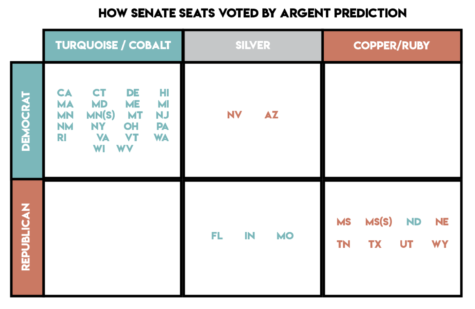
How each Senate seat voted 2018 versus how it should have voted according to the model ARGENT. The color of each congressional district indicates who controlled it before 2018
Democrats made big gains in governorships
Democrats gained seven governorships, primarily in Midwestern states. Republicans took the Alaska governorship from independent Bill Walker. Democrats took four of the eight Republican-held governorships in states that Clinton won in 2016 and three of the 19 Republican-held governorships in states that Trump won.
Democrats won five out of five cobalt seats, eight out of eight turquoise seats and three out of eight silver seats. Republicans won four out of four copper seats, and 11 out of 11 ruby seats. This means that ARGENT called 100 percent of non-silver Governor races correctly.
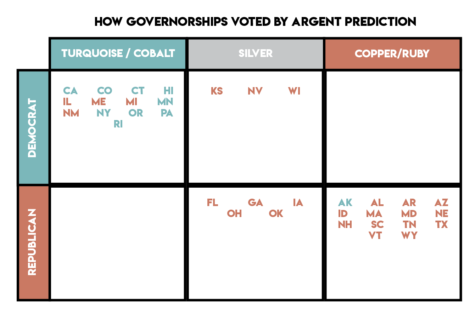
How each governor race voted in 2018 versus how it should have voted according to the model ARGENT. The color of each congressional district indicates who controlled it before 2018.
As for the legislatures…
Democrats made a few legislature gains that put them in a good position for 2020, but were disappointed in some states. They picked up six state legislatures, but most of these were in Democrat-leaning turf (New York, Colorado, etc.). Democrats also expanded their majorities in chambers that they already control and made progress in several states where Republicans had huge majorities that are now heavily dented. The following chart shows the control of each of the following 19 GOP held state legislatures in 12 states. Dark blue indicates the percentage of seats that Democrats held coming into 2018, light blue indicates the percentage that Democrats gained, and red indicates the percentage Republicans now hold. Not every chamber where Democrats made gains is listed.
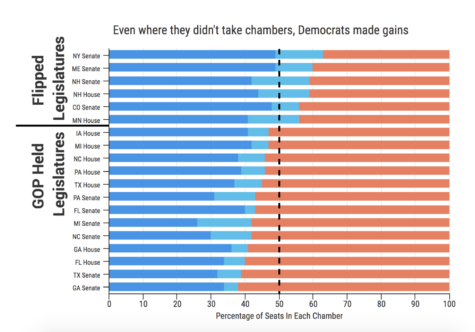
Gains made in state legislatures in 2018. Dark blue indicates the percentage of seats that Democrats held coming into 2018, light blue indicates the percentage that Democrats gained, and red indicates the percentage Republicans now hold. The top 6 are legislatures that the Democrats took control of. Not every chamber where Democrats made gains is listed.
A trifecta is when one party controls the governorship and both legislatures of a state. After 2016, Democrats had only 6 (they’ve since gained Washington and New Jersey) while Republicans had 26. After 2018, Democrats will have 14. The number is actually 17 if you count Massachusetts, Maryland and Vermont, which have Republican governors, but where Democrats have a supermajority in the legislatures (see below). Meanwhile Republicans will be down to 22.
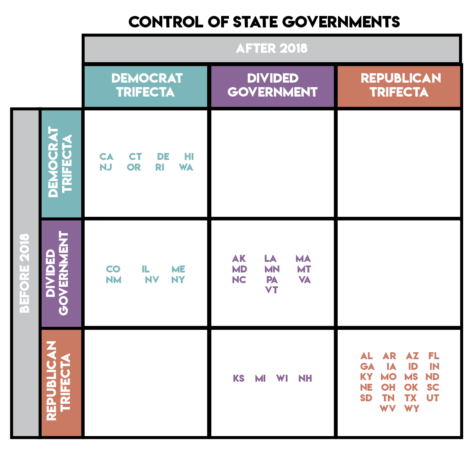
Control of state governments before and after 2018. A “trifecta” indicates when one party controls both legislatures and the governorship.
Also worth mentioning are the supermajorities. When one party has a sufficiently large majority (usually ⅗ or ⅔, but it depends on the state) in both legislatures they can pass certain kinds of legislation and override vetoes. Republicans lost five of these in three states while Democrats gained six in five states. This means that Democrats now have supermajorities in both chambers in eight states while Republicans will be down to 14. Republicans may also lose their supermajorities in Kansas, which will matter for incoming Democratic governor Laura Kelley, due to several defections.
These are not the only gains Democrats made on the state level; they flipped several Secretaries of State, Attorney Generals, state supreme court seats and so on. While these may not sound as important as the big-ticket items, these offices have huge impacts on voting rights, challenges to Trump’s executive orders and gerrymandering.
A few upsets worth mentioning
New York’s 11th congressional district, which includes Staten Island, was the only Republican-held House seat primarily composed of urban voters. The Obama-Trump district (which voted for Obama in 2012 and Trump in 2016) has a tumultuous political history with the other four boroughs of New York city, so it was something of a surprise when Democrat Max Rose unseated Republican incumbent Dan Donovan by six percent. Granted, this seat was listed as competitive by political handicappers, but it fell into the category of seats that would have been expected to flip had Democrats gained 60 seats rather than 40.
Oklahoma’s 5th congressional district was even less likely to flip than Staten Island; the Oklahoma City-based district was gerrymandered to benefit Republicans, Romney won it by 18 percent and Trump won it by 13 percent. The closest poll (and there weren’t many because this wasn’t thought to be competitive) showed Republican incumbent Steve Russell ahead by nine percent. Yet despite the lack of signs suggesting that this target was anything but on the horizon for Democrats, Kendra Horn won it by two percent.
But those two upsets are nothing compared to South Carolina’s 1st congressional district. The district, based in gerrymandered Charleston, was in the news earlier this year when incumbent, Republican Mark Sanford, was ousted in the primaries. However, this race was not remotely on my radar as a potential flip, so much so that I rated it as ruby, not copper. Yet Democrat Joe Cunningham still beat Republican Kate Arrington by two percent.
Outside of House races, the most surprising results in the Senate and Gubernatorial races were Florida Governor Rick Scott unseating incumbent Democratic Senator Bill Nelson and Democrat Andrew Gillum failing to defeat Republican Gubernatorial nominee Ron DeSantis. Both races went through contentious recounts. Even though both were rated silver, pundits had been looking at the Democrats as slight favorites in both, and their losses were incredibly devastating to Democrats in this crucial swing state.
Read Midterm Madness V to see what this means for 2020


